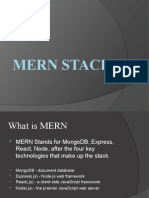100% found this document useful (1 vote)
346 views3 pagesNode.js Guide for Developers
Node.js is a JavaScript runtime built on Chrome's V8 engine that is used for building fast and scalable server-side and networking applications. It uses an event-driven, non-blocking I/O model that makes it lightweight and efficient for data-intensive real-time applications. Key features include being asynchronous and event-driven, very fast performance, and high scalability with a single-threaded model. Popular companies that use Node.js include eBay, Microsoft, and Yahoo. It is well-suited for I/O bound applications, data streaming, real-time applications, and APIs.
Uploaded by
ZdtjbCopyright
© © All Rights Reserved
We take content rights seriously. If you suspect this is your content, claim it here.
Available Formats
Download as PDF, TXT or read online on Scribd
100% found this document useful (1 vote)
346 views3 pagesNode.js Guide for Developers
Node.js is a JavaScript runtime built on Chrome's V8 engine that is used for building fast and scalable server-side and networking applications. It uses an event-driven, non-blocking I/O model that makes it lightweight and efficient for data-intensive real-time applications. Key features include being asynchronous and event-driven, very fast performance, and high scalability with a single-threaded model. Popular companies that use Node.js include eBay, Microsoft, and Yahoo. It is well-suited for I/O bound applications, data streaming, real-time applications, and APIs.
Uploaded by
ZdtjbCopyright
© © All Rights Reserved
We take content rights seriously. If you suspect this is your content, claim it here.
Available Formats
Download as PDF, TXT or read online on Scribd
/ 3

























































































